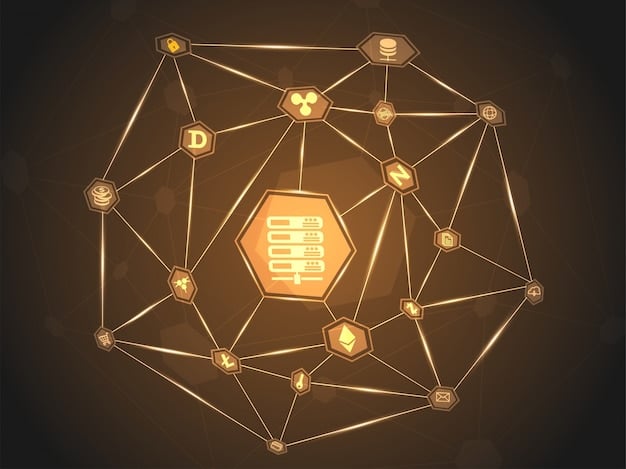Blockchain Voting Systems: Secure Elections in the US?

Blockchain voting systems are being explored in the US as a potential solution to enhance election security and transparency, aiming to address concerns about voter fraud and accessibility.
The integrity and security of elections are paramount to any democratic society. In the United States, concerns about voter fraud, accessibility, and transparency have led to the exploration of innovative solutions. Among these, blockchain voting systems have emerged as a potentially transformative technology.
Understanding Blockchain Technology
Before diving into the specifics of blockchain voting systems, it’s crucial to understand the underlying technology. Blockchain, at its core, is a decentralized, distributed, and immutable ledger. This means that data is stored across multiple computers, making it extremely difficult to alter or tamper with.
How Blockchain Works
Blockchain operates using cryptographic principles to secure and verify transactions. Each block in the chain contains a set of transactions, a timestamp, and a cryptographic hash of the previous block, creating a chain-like structure. This structure ensures that any alteration to a single block would require altering all subsequent blocks, which is computationally infeasible in most scenarios.
- Decentralization: No single entity controls the blockchain, reducing the risk of manipulation.
- Immutability: Once a transaction is recorded, it cannot be altered or deleted.
- Transparency: All transactions are publicly viewable on the blockchain network, although identities can be anonymized.
The decentralization, immutability, and transparency of blockchain make it an attractive technology for various applications, including voting systems. Its potential to enhance security and trust is a key factor driving its exploration in the electoral process.

The Promise of Blockchain Voting Systems
Blockchain voting systems promise to address several key challenges in traditional voting processes. By leveraging the inherent security and transparency of blockchain technology, these systems aim to improve election integrity and voter trust.
Enhanced Security
Traditional voting systems are vulnerable to various forms of fraud, including ballot stuffing, voter impersonation, and electronic hacking. Blockchain voting systems can mitigate these risks by ensuring that each vote is securely recorded and verified on the blockchain. The immutable nature of the blockchain makes it extremely difficult for malicious actors to alter vote counts.
Increased Transparency
One of the significant benefits of blockchain voting systems is increased transparency. All transactions, including votes, are publicly viewable on the blockchain. This allows voters and election officials to verify the integrity of the election without compromising voter anonymity.
- Auditability: Blockchain voting systems provide a clear and auditable record of all votes cast.
- Reduced Fraud: The decentralized and immutable nature of blockchain makes it harder to commit voter fraud.
- Voter Confidence: Transparency can increase voter confidence in the election process.
However, the implementation of blockchain voting systems is not without its challenges. Concerns about scalability, accessibility, and privacy must be addressed to ensure that these systems are viable and trustworthy.
Challenges and Concerns
Despite the potential benefits, implementing blockchain voting systems in the US faces several significant challenges. These challenges range from technical limitations to social and political considerations.
Scalability Limitations
Blockchain networks can struggle to handle the volume of transactions required during a national election. Traditional blockchain networks like Bitcoin and Ethereum have limited transaction processing capabilities, which could lead to bottlenecks and delays during voting.
Accessibility Issues
Ensuring that all eligible voters can participate in blockchain voting systems is a major concern. Access to technology, digital literacy, and internet connectivity are all potential barriers to participation. Voters with disabilities or those in rural areas may face additional challenges.

Privacy Concerns
While blockchain offers transparency, it’s crucial to protect voter privacy. Linking votes directly to voters’ identities could lead to coercion or discrimination. Developing methods to anonymize votes while maintaining auditability is a key challenge.
Addressing these challenges requires careful planning, robust testing, and collaboration between technologists, election officials, and policymakers. It’s essential to ensure that blockchain voting systems are not only secure and transparent but also accessible and equitable for all voters.
Evaluating Feasibility in the US Context
The feasibility of implementing blockchain voting systems in the US depends on several factors, including legal frameworks, technological readiness, and public acceptance. A comprehensive evaluation must consider these factors to determine whether blockchain voting is a viable solution.
Legal and Regulatory Considerations
Current election laws and regulations vary widely across the US states, making it challenging to implement a uniform blockchain voting system. Legal frameworks must be updated to accommodate blockchain technology while ensuring compliance with existing election laws.
Technological Infrastructure
The US must invest in the technological infrastructure required to support blockchain voting systems. This includes secure hardware, reliable internet connectivity, and robust cybersecurity measures.
- Pilot Programs: Conducting pilot programs and trials in small-scale elections can provide valuable insights into the feasibility of blockchain voting.
- Collaboration: Collaboration between government agencies, technology companies, and academic institutions is essential for developing secure and reliable blockchain voting systems.
- Public Education: Educating the public about blockchain technology and its potential benefits can increase voter confidence and acceptance.
Ultimately, the success of blockchain voting systems in the US will depend on a combination of technological innovation, legal reform, and public engagement.
Case Studies and Pilot Programs
Several countries and regions have experimented with blockchain voting systems in pilot programs and small-scale elections. These case studies provide valuable lessons and insights into the potential and limitations of blockchain voting.
West Virginia Pilot Program
West Virginia conducted a pilot program in 2018 using a blockchain-based mobile voting app for overseas military personnel. While the program aimed to increase accessibility for remote voters, it also faced criticism regarding security vulnerabilities and privacy concerns.
Swiss Canton of Zug
The Swiss Canton of Zug has implemented blockchain-based voting for municipal referendums. This initiative allowed residents to vote securely and transparently using a mobile app, providing valuable experience in deploying blockchain voting in a real-world setting.
These case studies highlight the importance of rigorous testing, security audits, and user feedback in the implementation of blockchain voting systems. They also demonstrate that blockchain voting is not a one-size-fits-all solution and must be tailored to the specific needs and context of each election.
The Future of Blockchain Voting in the US
The future of blockchain voting in the US remains uncertain but promising. As technology evolves and public awareness grows, blockchain voting systems may become a more viable option for enhancing election security and transparency. However, careful planning, rigorous testing, and ongoing evaluation are essential to ensure its success.
Potential Benefits
If implemented successfully, blockchain voting systems could offer numerous benefits, including increased voter turnout, reduced election costs, and enhanced public trust in the electoral process. The technology has the potential to revolutionize how elections are conducted in the US.
Ongoing Research and Development
Continued research and development are needed to address the challenges and concerns associated with blockchain voting. This includes developing scalable and secure blockchain networks, improving accessibility for all voters, and protecting voter privacy.
The implementation of blockchain voting will likely be a gradual process, with pilot programs and small-scale elections paving the way for broader adoption. It requires a collaborative effort involving technologists, election officials, policymakers, and the public.
| Key Point | Brief Description |
|---|---|
| 🔐 Enhanced Security | Blockchain’s immutability and decentralization reduce fraud risks. |
| 🗳️ Increased Transparency | Publicly viewable transactions enhance election integrity. |
| 🌐 Accessibility Challenges | Digital access and literacy are key barriers to overcome. |
| ⚖️ Regulatory Hurdles | Existing election laws need updates to accommodate blockchain. |
Frequently Asked Questions
▼
Blockchain voting uses blockchain technology to record and verify votes. Each vote is a transaction recorded on a distributed ledger, making it more secure and transparent than traditional methods.
▼
Blockchain voting is highly secure due to its decentralized and immutable nature. Once a vote is recorded, it cannot be altered or deleted, reducing the risk of fraud and manipulation.
▼
Key challenges include scalability, accessibility, and privacy. Ensuring that blockchain systems can handle large volumes of votes while remaining accessible to all voters is critical.
▼
Yes, blockchain voting has been tested in pilot programs and municipal referendums in countries like Switzerland and the United States (West Virginia). These trials provide practical insights into its potential.
▼
The future is promising but uncertain. Continued research, development, and public education are needed to address concerns and pave the way for broader adoption of blockchain voting systems.
Conclusion
In conclusion, blockchain voting systems hold the potential to transform elections in the US by enhancing security, transparency, and accessibility. While significant challenges remain, ongoing research, pilot programs, and public engagement could pave the way for a more secure and trustworthy electoral process.





